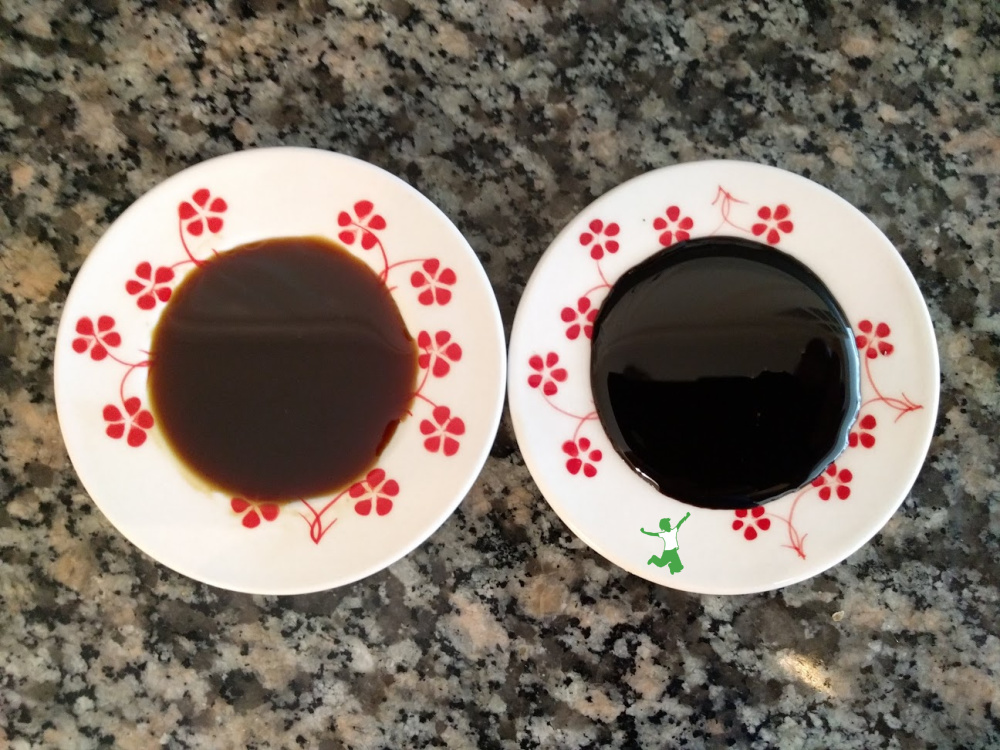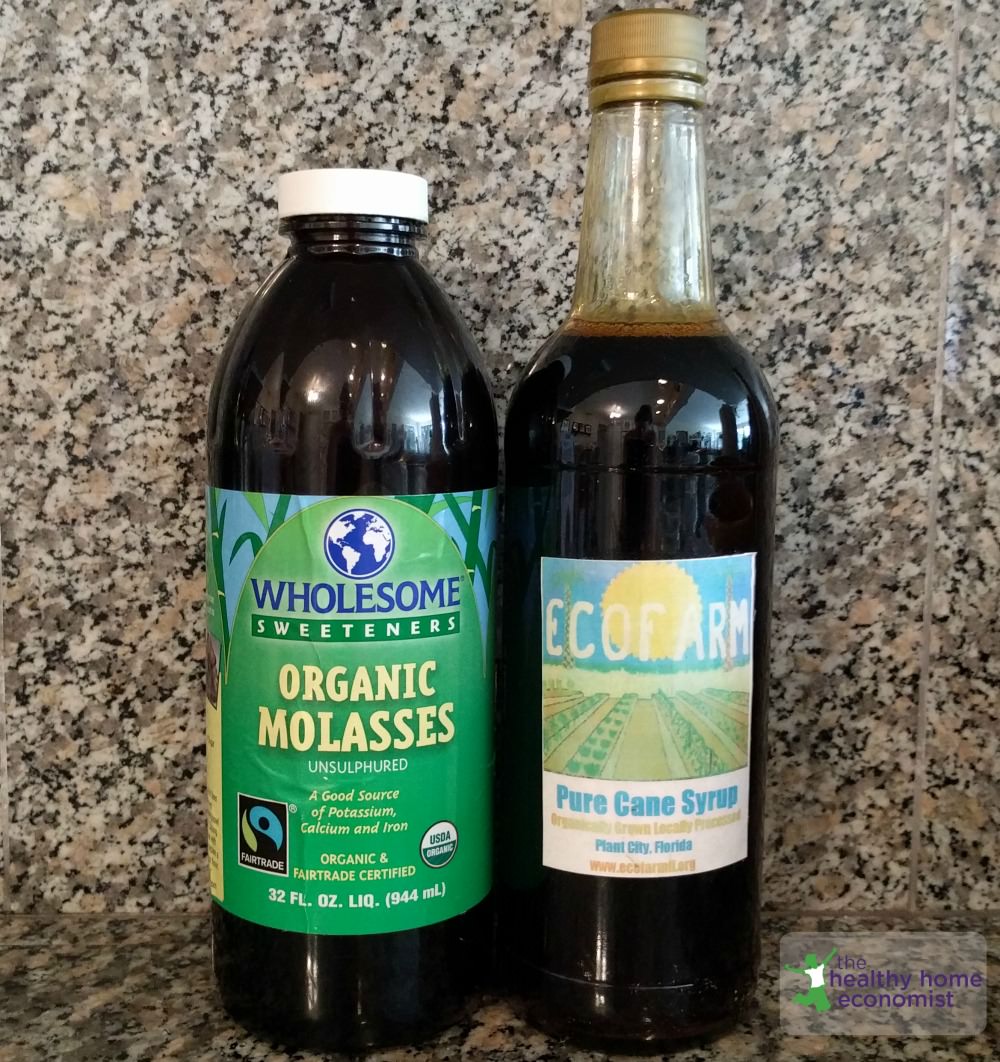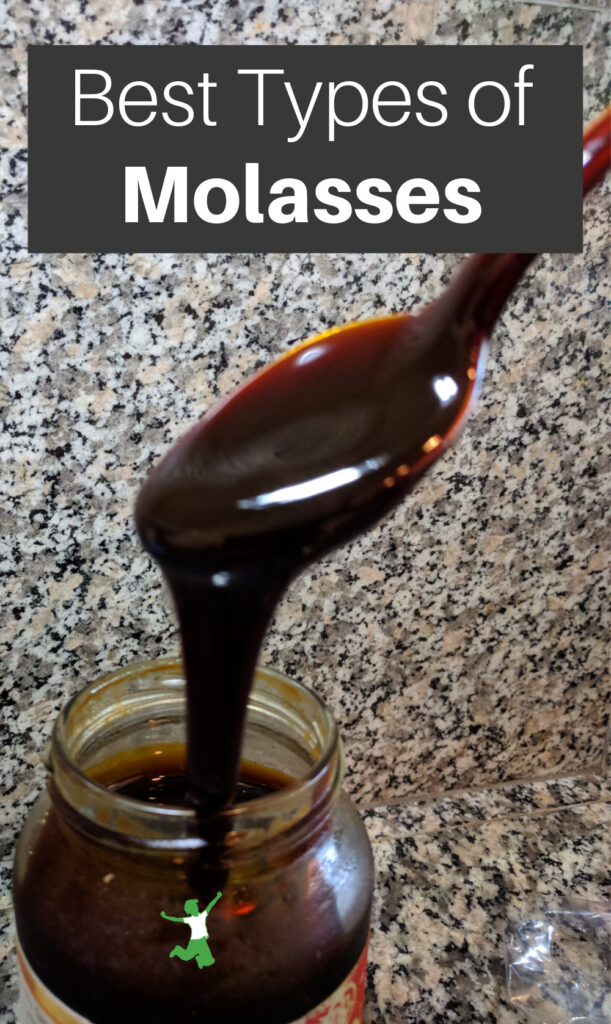Table of Contents[Hide][Show]
Light, dark, and blackstrap molasses is a traditional, whole sweetener used since colonial times. How to choose the most nutritious kind to avoid the molasses identified via research to contain toxic residues.

With so many new sweeteners on the market, almost all wanting to lay claim to the healthy label, it is easy to overlook certain older, tried and true choices. Molasses is one such traditional sweetener that seems to have lost its luster amidst an ever-growing crowd of competitors.
Sometimes I wonder if all these choices are a deliberate strategy on the part of Big Food. Confusing the consumer into sweetener submission, if you will.
Such an approach could potentially dilute the negative rap of unhealthy sweeteners while simultaneously causing consumers to overlook healthy choices in favor of new, exciting, less healthful (but more profitable) offerings that look the same (e.g., sugar beet syrup).
Molasses…Grandma’s Go-To
Case in point. Molasses is one of the most basic sweeteners out there. It’s been around forever, and my Great Grandma baked gingerbread cookies with it.
Yet, when I went hunting for molasses at the supermarket, I could only find two brands in small bottles placed in highly undesirable shelf space. I had to ask a store clerk to help me find it!
I was most surprised to find that blackstrap molasses was nowhere to be found. More on that later.
Is molasses deserving of this low-ranked placement in the eyes of the consumer? Given its traditional health benefits, should you be using it in your kitchen regularly and if so, what types?
Are there some varieties that should be avoided? Hint: YES!
Let’s examine this sweetener a bit further and find out.
Where Does Molasses Come From?
Consumed in Brazil since colonial times, molasses is a thick, dark, strong-tasting, semi-sweet syrup. It is made by boiling down the juice extracted from either sugarcane or sugar beet crops.
Its varying shades of brown and strong flavor partially result from the caramelizing of the fructose and glucose molecules during the cooking process.
Note the picture above that shows dark molasses and blackstrap side by side. Quite a difference!
Molasses is different than sugar beet or cane syrup, which are also dark and thick.
You may have noticed that cane syrup is becoming popular with some restaurants as a lower-cost alternative to maple syrup for drizzling on pancakes and waffles.
Cracker Barrel is one that switched a few years ago. A maple syrup/cane syrup blend or pure cane syrup is used instead.
While the majority of the molasses in the world comes from sugar cane and sugar beets, many other foods can be used to make it too.
Dates, mulberries, pomegranates, carob, and even grapes are less common sources of this traditional sweetener.
Types of Molasses
The molasses most people are familiar with comes from sugar cane. Three types of cane molasses are available on the market.
Light
This molasses comes from the first boiling of the sugarcane. Also called Barbados, it is mild and sweet-tasting, only slightly stronger than cane syrup.
It also contains the least amount of nutrients. Many recipes that call for molasses mean the light version. The color is similar to golden or amber maple syrup.
Dark
The second boiling produces dark molasses. This is what is normally used in gingerbread cookies.
The color and consistency are very similar to dark maple syrup and yacon syrup.
Blackstrap
This is the strongest and most nutrient-rich option. It is produced from yet a third boiling. While rich in nutrients, it is quite bitter in taste, and thus not generally used in cooking.
It is often used as a fertilizer amendment or in animal feed.
The consistency of blackstrap is quite thick. You know the saying, “slow as molasses”? Clearly, whoever made this up was referring to blackstrap!
Sugar Beet Molasses
Molasses from sugar beets is not fit for human consumption as the processing results in a highly unpalatable final product.
However, it is used extensively in animal feed, especially for dairy and beef cattle.
In the USA, all sugar beets are now genetically modified. Thus, it is wise to avoid any products containing molasses derived from beet sugar.
So, if you are purchasing grass-fed beef or dairy and your farmer uses molasses as a supplement, it would be a good idea to ask about their sourcing!
Nutritional Profile
Cane molasses is very rich in minerals, even more so when obtained from plants grown in healthy soil.
It is rich in some vitamins too, particularly the elusive Vitamin B-6 which is extremely heat sensitive and difficult to obtain unless unprocessed foods like raw milk are regularly consumed.
The list below details the daily value per serving for the top four nutrients.
- Iron (4% DV)
- Calcium (4% DV)
- Potassium (8% DV)
- Magnesium (12% DV)
- Vitamin B-6 (5% DV)
Cane Syrup vs Molasses
While very similar in color and consistency, cane syrup and molasses are not the same!
Cane syrup is made by first crushing the sugarcane to extract the juice. The liquid is then gently boiled to remove some of the water. What remains is cane syrup: semi-thick, sweet, and not at all bitter.
A farmer in my community makes cane syrup in a traditional, artisanal manner, boiling down and bottling by hand. It’s delicious! Here’s some in my pantry next to a bottle of organic molasses.

If the boiling down process continues, removing even more water, some of the sucrose in the syrup crystallizes. This “raw sugar” is extracted and the remaining syrup is molasses: acidic, bittersweet, and incredibly mineral-rich. (1)
Depending on the degree to which it is concentrated, molasses can be light or dark. These varieties contain a sugar content of around 70%.
Blackstrap Molasses
Further boiling down causes thermal decomposition to occur. The result is that about a third of the remaining sugars carbonize. An extremely thick, black, bitter, and salty sludge is what remains.
This sediment is blackstrap molasses! Blackstrap differs from light or dark in that it has a sugar content of only about 45%.
It is also a bit high in sodium. For this reason, unless a recipe specifically calls for blackstrap, use light or dark molasses instead. (2)
Vitamins and Minerals
Because blackstrap molasses is so concentrated and contains about 1/3 less sugar (glycemic index of 55) than regular molasses, you would expect it to contain more vitamins and minerals.
This is exactly the case as you can see from the significantly higher daily values per serving for the important nutrients below.
- Iron (15% DV)
- Calcium (10% DV)
- Potassium (20% DV)
- Magnesium (8% DV)
- Vitamin B-6 (10% DV)
Dark is Best
When it comes to molasses, the darker the better as that is where the nutrition is.
Yes, molasses is healthy and very good for you when you use the good stuff!
This sweetener is also appropriate for some special diets as all types of molasses are gluten-free.
However, because it is derived from cane sugar, it is not appropriate for gut healing protocols such as GAPS which temporarily restrict all disaccharide sweeteners.
Light and dark molasses are certainly fine but nutritionally will appear to only get you somewhere close to what maple syrup has to offer. Blackstrap molasses offers much more nutrition though! Some sources even refer to it as a superfood.
Let’s examine 5 of the most notable health benefits of molasses.
High in Iron
Blackstrap molasses is one of the highest foods in easily absorbed iron. In fact, I successfully used it to keep my iron levels high and avoid pregnancy anemia.
I mixed 2 tablespoons in a glass of raw grass-fed milk (safe during pregnancy!) once or twice a day during the last trimester. Despite the potential of calcium to block some of the iron absorption, this worked very well. (3)
I absorbed enough so that my iron levels stayed high, and I was able to avoid those constipating inorganic iron pills typically given to pregnant women (that usually don’t even work that well!).
Good for Anemia?
For non-pregnancy related anemia, consult with your holistic functional physician first before supplementing with blackstrap.
The reason is that gut imbalance can sometimes involve an overgrowth of iron-loving pathogens such as Actinomyces spp., Mycobacterium spp., pathogenic strains of E. coli, Corynebacterium spp., along with many others.
Previous use of The Pill or antibiotics makes one especially prone to anemia issues from the overgrowth of these microbes.
Electrolytes
For those suffering from leg cramps or muscle spasms, supplementing with blackstrap molasses may prove helpful due to the heavy-hitting combo of both potassium and magnesium.
Loaded with Antioxidants
The Journal of Food Science reports that molasses is high in beneficial antioxidants. Researchers found that extracted compounds exhibited the capacity to protect against oxidative damage by decreasing DNA breakage. (4)
In fact, of all the whole sweeteners on the market, blackstrap molasses tests highest in antioxidant activity followed by barley malt and date sugar. (5)
Positive Effects on Reproductive Health
An in vivo 2016 study published in the Iranian Journal of Basic Medical Sciences identifies sugar cane molasses as a supplement that may enhance testosterone production by the male reproductive system.
These findings are in accordance with previous studies showing molasses having a beneficial effect on male reproductive health. (6)
Helps with Constipation
One teaspoon of dark molasses added to a batch of homemade formula helps resolve constipation in babies.
The late Mary Enig PhD, a well-respected nutritionist and researcher, recommended this remedy.
Molasses is known to get things moving for some adults too!
Unsulphured vs Sulphured
Within the three types of cane sugar molasses, there is the additional category of sulphured and unsulphured molasses.
When molasses is sulphured, it contains the added preservative sulfur dioxide. While the mineral sulphur is beneficial in the diet, this substance is not. Food manufacturers use it for three reasons.
First, it inhibits molasses’ natural tendency to ferment. Secondly, it protects against the unlikely risk of mold contamination. This substance also serves as a bleaching agent for the molasses, lightening the color.
While sulfur dioxide makes the molasses more shelf-stable, it also makes it less sweet. There are also toxicity concerns with sulphur dioxide. One in nine asthmatics reports symptoms worsening after consuming foods containing it. (7)
Thus, most molasses brands have moved away from adding sulphur dioxide to their products.
Unsulphured molasses is highly preferable and fortunately easy to find. This information should be listed front and center on the label, so consumers don’t have to read the ingredients to determine if the additive is present.
Storage
Since natural molasses doesn’t contain sulphur dioxide, it is more likely to ferment especially once a bottle is opened and exposed to air.
To prevent this from occurring, unsulfured molasses should be stored in a cool, dark place or the refrigerator.
Is Organic Worth the Price?
Molasses is one of those products that is easy to label all-natural even if it is made from crops grown in the most industrial of fashions. As a consumer, you can easily find molasses made from both conventional and organic inputs. Be smart about the choices you make!
Given that molasses is the by-product of making refined sugars, you definitely don’t want conventional molasses. Sugarcane farmers grow their crops using a wide variety of herbicides and pesticides. (8)
To play it safe, make sure you stick with unsulphured, organic molasses brands no matter if you buy light, dark, or blackstrap.
Molasses vs Alternative Sweeteners
Any grade of unsulphured molasses is superior to refined sugars. These would include white sugar, high fructose corn syrup, rice syrup, and others.
It would also be a far better and safer choice than any of the artificial sweeteners out there such as aspartame (Nutrasweet), acesulfame K, or sucralose.
As mentioned above, the appropriate use depends on both the type of unsulphured molasses you use and a degree of personal preference.
Enjoying at Home
Both light and dark molasses have a long history of use in a variety of cuisines as a substitute for maple syrup.
Dark molasses has a strong flavor and more minerals. As an addition to barbecue sauce and similar dishes, it adds more depth and complexity to the taste of the meal.
Some specialty beers, such as stouts and porters, achieve their distinctive flavor because of molasses. It may also serve as an emulsifier in salad dressings.
The uses for molasses are many and if you are using organic unsulphured molasses, you should not shy away from them!
Cooking Considerations
While you can cook with blackstrap, the high salt and low moisture content, along with the acidity and bitterness, may require changes to your recipes unless they specify its use.
Also, substituting blackstrap for light or dark molasses is a disaster waiting to happen.
Blackstrap takes up far less space than dark per ounce since it is far thicker and denser. Using it as a natural mineral supplement is optimal in the majority of cases.
Do you cook with molasses or supplement with it as I did during my three pregnancies? If so which kind and what are your favorite recipes? Have you observed any health benefits from using it in your diet?

(1, 2) The Difference Between Blackstrap Molasses and True Molasses
(3) Iron Disorders Institute. Diet and Nutrition
(4) Antioxidant activity of sugar molasses, including protective effect against DNA oxidative damage
(5) Total antioxidant content of alternatives to refined sugar
(6) The effect of sugar cane molasses on the immune and male reproductive systems using in vitro and in vivo methods
(7) Sulphur dioxide in foods and beverages: its use as a preservative and its effect on asthma
(8) Pesticide Use on Sugarcane








Thanks, Sarah, for doing all the research and putting it together for us. I just checked the molasses I bought recently to see if it’s unsulfured (it is–Wholesome). And as I don’t use it often, I decided to try to freeze some (big bottle!) in small amounts. I put the remaining, still in the bottle, in the refrigerator.
Excellent article, thank you! I use date molasses often, especially in my chili!
Just a quick question. When you all say a spoonful a day are you taking it straight from the spoon or taking mixing a spoonful in something. I want to try this to get my iron levels up but I won’t be baking with it or doing any milk products at this time. Thank you, and I really enjoyed this article!